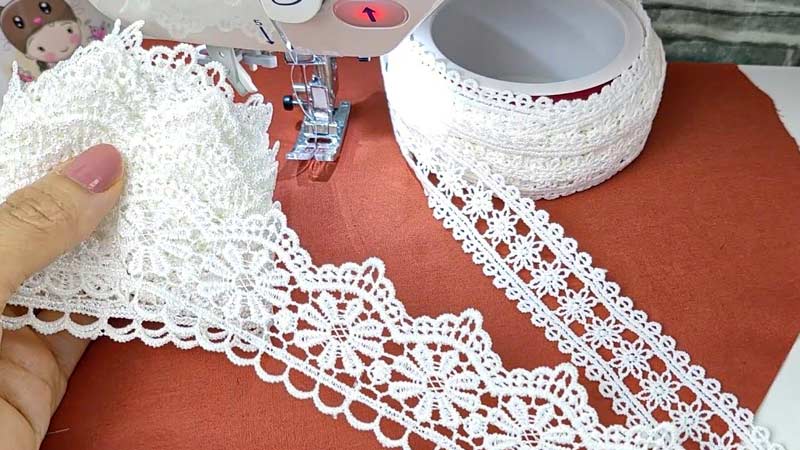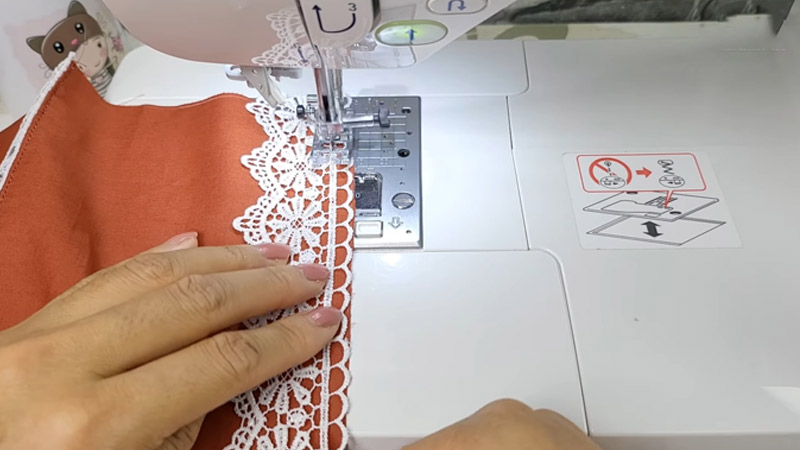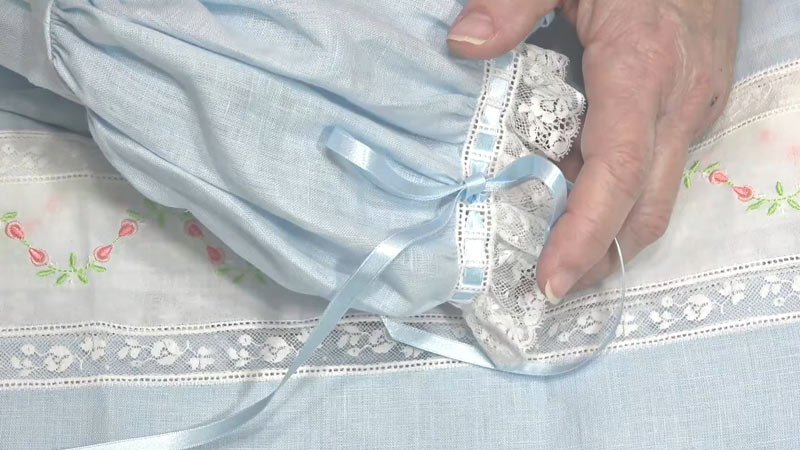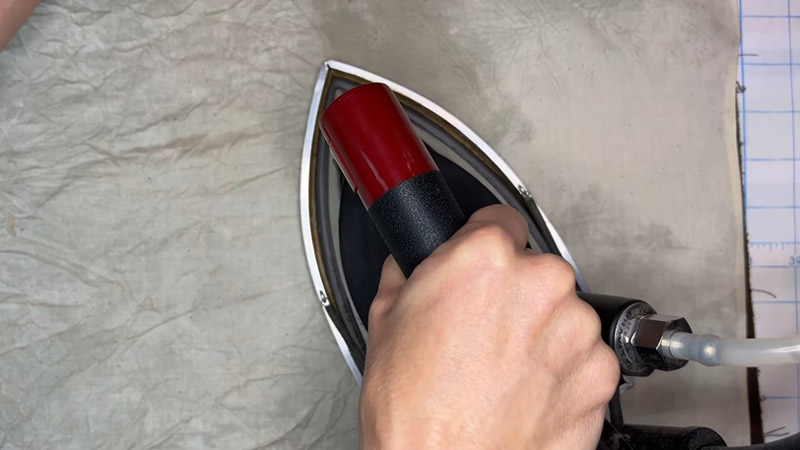Whether lace and cotton trim should be preshrunk before sewing is pivotal in achieving a successful garment, lace and cotton, being natural fibers, are susceptible to shrinkage when exposed to heat and moisture.
Preshrinking is often recommended to prevent distortion in seams, ensure consistent sizing, and maintain the garment’s overall structure.
However, there are instances where intentional shrinkage for design aesthetics, specific care instructions, or time constraints may lead to the decision to skip this step.
This nuanced exploration of whether to preshrink lace and cotton trim navigates the balance between practicality, aesthetic choices, and the unique demands of diverse sewing projects.

What Is Preshrinking?
Preshrinking, or prewashing, is a crucial textile preparation process where fabric or trims undergo treatment before being used in sewing projects.
Particularly vital for materials with natural fibers like cotton, preshrinking helps mitigate the risk of post-construction shrinkage.
This process involves washing and, in some cases, drying the material according to care instructions to simulate conditions it might encounter during regular use.
By addressing potential shrinkage beforehand, preshrinking ensures fabric stability, preventing distortions or uneven shrinkage in the final garment.
A standard practice in sewing and preshrinking contributes to the finished product’s longevity, fit, and overall quality, allowing for a more reliable and professional outcome.
Should Lace and Cotton Trim Be Preshrunk Before Sewing?
When deciding whether to preshrink lace and cotton trim before sewing, the answer can be “yes” and “no” depending on various factors.
Yes, lace and cotton trim should be pre-shrunk before sewing. Preshrinking helps prevent fabric distortion and ensures the final garment maintains its shape after washing.
Cotton, a natural fiber, is prone to shrinking when exposed to water and heat. Preshrinking the trim eliminates the risk of post-sewing shrinkage, preventing any misalignment or puckering in the finished product.
Often made from delicate fibers like cotton or nylon, lace can also experience shrinkage. Preshrinking lace prevents distortion, maintains the intended design, and ensures a proper fit.
No, preshrinking may not be necessary for all projects. Some designers intentionally use the potential shrinkage to achieve a specific effect or texture in the final garment.
In cases where slight shrinkage is acceptable, skipping the preshrinking step may be a stylistic choice.
However, this approach requires careful consideration of the fabric’s characteristics and the desired outcome, as it may result in unexpected changes to the garment’s size and appearance after laundering.
When You Should Preshrunk Lace and Cotton Trim Before Sewing?

Preshrinking lace and cotton trim before sewing is crucial to ensure that your finished garment maintains its shape and size after washing.
Both lace and cotton can shrink when exposed to heat and moisture, and failing to preshrink them may result in distorted or misshapen seams, leading to an ill-fitting final product.
Here are some situations in which preshrinking lace and cotton trim is highly recommended:
Natural Fiber Content
Cotton, a widely used natural fiber, is valued for its breathability, comfort, and versatility in clothing. Lace, a delicate fabric often used for decorative purposes, frequently incorporates natural fibers like cotton.
These natural fibers have inherent characteristics that make them susceptible to changes in size when exposed to heat and moisture. Unlike synthetic fibers, they can absorb water and contract, leading to shrinkage.
Therefore, when working with trims containing cotton or other natural fibers, it is highly advisable to preshrink them before incorporating them into your sewing projects.
Preventing Garment Distortion
Certain fabrics, especially those with high cotton content or cotton blends, are known for their tendency to shrink when washed.
When you attach lace and cotton trim to such fabrics without preshrinking, you risk distortion in the seams.
The fabric may react to the first wash by puckering or pulling unevenly, compromising the overall appearance and fit of the garment.
Preshrinking the trim ensures that any potential shrinkage is addressed beforehand, contributing to a more stable and well-maintained garment structure.
Ensuring Consistent Sizing
Consistency in sizing is crucial for achieving a polished and professional look in your sewing projects.
If the lace and cotton trim are not preshrunk, there is a risk that they might shrink post-construction, leading to uneven edges or hems.
This inconsistency can detract from the visual appeal of the garment and may even affect its overall functionality.
Preshrinking the trim ensures it maintains its intended size, allowing for a harmonious integration with the rest of the garment.
Washing and Care Instructions
Understanding the expected care routine for the final garment is imperative when deciding whether to preshrink trim.
If the garment is intended for regular washing or will be exposed to humidity, preshrinking the lace and cotton trim becomes essential.
By doing so, you mitigate the risk of the trim shrinking at a different rate than the rest of the garment, which could result in an uneven appearance or compromised structural integrity over time.
Complex Garment Construction
In intricate or complex garment constructions, where multiple layers, delicate details, or precise alignment are critical, preshrinking the trim becomes even more critical.
The dimensional stability of each component, including the trim, is essential for maintaining the intended structure and design.
Preshrinking helps prevent discrepancies in size, ensuring that the intricate elements of the garment come together seamlessly during the sewing process.
Test Swatches
Before embarking on your main sewing project, it’s wise to conduct a preliminary test by preshrinking small swatches of both the fabric and the trim.
This allows you to observe any potential shrinkage, assess how the materials interact, and adjust your cutting and sewing plans accordingly.
Testing in advance serves as a valuable precautionary step, helping you achieve a more accurate and professional final result.
When You Should Not Preshrunk Lace and Cotton Trim Before Sewing?

While preshrinking lace and cotton trim is generally advisable for various reasons, there may be situations where skipping this step could be appropriate.
Here are some scenarios when you might choose not to preshrink lace and cotton trim before sewing:
Intentional Shrinkage for Design Aesthetics
In fashion design, deliberate choices are often made to enhance the visual appeal of garments. Intentional shrinkage can create a textured or vintage look in the finished product.
By skipping the preshrinking step, designers allow the fabric and trim to undergo controlled shrinkage during subsequent washes.
This intentional process results in a garment with a slightly shrunken or puckered appearance, adding character and uniqueness to the overall design.
The decision to forgo preshrinking becomes a purposeful and integral part of achieving the desired aesthetic.
Stretch Considerations
Certain garment types, such as swimwear or activewear, rely on the natural elasticity of fabrics to provide comfort and functionality.
In such cases, skipping preshrinking may be appropriate, as the materials’ inherent stretch and shrinkage characteristics contribute to the garment’s performance.
However, this decision should be made carefully considering the project’s specific requirements.
Understanding how the fabric and trim will behave regarding stretch and recovery is crucial to ensuring the garment meets the intended functional and aesthetic goals.
One-Time Wear or Display
For garments designed for a singular event or display purposes, where regular washing and long-term use are not anticipated, preshrinking the trim may be less critical.
The short lifespan of the garment may not justify the additional effort and time associated with preshrinking.
In such instances, designers may prioritize the immediate visual impact of the garment for its intended purpose, allowing for more flexibility in the construction process.
Experimental or Artistic Projects
Artistic expression often thrives on unpredictability and spontaneity. In experimental or artistic projects, designers may intentionally choose not to preshrink the trim to embrace the unexpected changes in texture and appearance during subsequent washing or wearing.
This approach contributes to creating a unique and unconventional final product, where the fabric’s evolution becomes integral to the artistic narrative.
Specific Care Instructions
Carefully adhering to specific care instructions provided with the trim is crucial. If the trim comes with recommendations against preshrinking, respecting those guidelines is essential.
Some specialty trims may be treated or coated in a way that makes preshrinking unnecessary or undesirable, and following these instructions ensures the longevity and integrity of the trim.
Time Constraints
When time is a limiting factor, such as last-minute projects or tight deadlines, skipping preshrinking may be a pragmatic decision to expedite the sewing process.
However, designers should be aware of potential consequences, especially if the garment is expected to undergo washing or regular wear.
Balancing time constraints with project requirements is essential to achieving a satisfactory outcome.
Synthetic Fiber Dominance
If the trim is primarily composed of synthetic fibers, which typically exhibit minimal shrinkage compared to natural fibers like cotton, preshrinking may be less critical.
Synthetic materials like polyester or nylon often maintain their shape and size even after washing.
In projects where synthetic fibers dominate, skipping preshrinking may be less noticeable, and designers can focus on optimizing other aspects of the construction process.
How to Shrink Lace? Step-By-Step Guide

Shrinking lace can be achieved by subjecting it to controlled conditions that simulate the effects of heat and moisture.
However, it’s essential to note that not all types of lace are suitable for intentional shrinking, and the results may vary based on the lace’s fiber content and construction.
Here’s a step-by-step guide on how to shrink lace:
Hot Water Soak
Immersing lace in hot water effectively encourages natural fiber, like cotton, to contract and shrink.
Ensure the water is sufficiently hot but not boiling, and submerge the lace for an extended period, allowing the heat to penetrate the fibers.
This gradual approach minimizes the risk of over-shrinking while facilitating a controlled reduction in size.
It’s crucial to exercise caution and monitor the process, as prolonged exposure to hot water might affect the lace’s delicate structure.
Steam Treatment
Utilizing steam for lace shrinking involves using a garment steamer or steam iron. By holding the lace taut and exposing it to steam, the heat relaxes the fibers, facilitating controlled shrinking.
This method benefits delicate or intricate lace patterns, allowing for a more precise heat application without submerging the entire fabric.
However, careful attention is required to prevent scorching or damage to the lace during the steaming process.
Warm Wash and Dry
Opting for a warm water wash in a washing machine followed by either low-heat drying or air-drying provides a practical approach to lace shrinking. Warm water helps open the fibers, making them more receptive to contraction during drying.
This method is suitable for natural fiber lace but necessitates careful monitoring to prevent excessive shrinkage. Air-drying is recommended for more delicate lace varieties, ensuring a controlled process.
Repeated Washing
Gradual shrinkage can be achieved by subjecting lace to multiple washing and drying cycles. Each cycle contributes incrementally to the overall reduction in size, providing greater control over the process.
This method is effective for achieving a nuanced level of shrinkage, especially when working with lace that may be sensitive to abrupt changes in size.
Consult Care Instructions
Before attempting any shrinking method, it is imperative to consult the care instructions provided with the lace.
Certain types of lace, especially synthetic blends or those with intricate embellishments, may not respond well to intentional shrinking.
Following the recommended care guidelines ensures the fabric retains its structural integrity throughout the process, preventing potential damage.
Test Swatch
Conducting a test swatch before applying any shrinking method to the entire piece of lace is prudent.
This small-scale test allows for observation of how the lace responds to shrinking, providing insights into the degree of contraction and potential alterations in texture.
Adjustments to the shrinking process can be made based on the results of the test swatch, helping to avoid unintended consequences and achieve the desired outcome in the final piece.
How to Prewash Cotton Fabric?

Prewashing cotton fabric is a crucial step in the sewing process to prevent future shrinkage and ensure the stability of your finished garment.
Here’s a comprehensive guide on how to prewash cotton fabric:
1. Sort Fabrics
When sorting fabrics for prewashing, the goal is to prevent color bleeding and address varied care requirements. Separating light-colored fabrics from dark ones is crucial to avoid color transfer during washing.
Additionally, segregating fabrics with different care instructions or blends ensures each fabric type receives the appropriate treatment, promoting optimal results in the prewashing process.
2. Check for Colorfastness
Before commencing the prewashing process, conduct a colorfastness test on a small, inconspicuous piece of the fabric.
If color bleeding occurs, washing the fabric separately or using a color catcher during the wash is advisable.
This precautionary step helps preserve the integrity of the colors and prevents unwanted color transfer between fabrics.
3. Choose the Right Detergent
Selecting a mild detergent is essential during prewashing to prevent harsh chemicals from affecting the fabric.
Fabric softeners should be avoided as they can leave residues that interfere with the absorption of dyes and finishing agents in the fabric, ensuring a clean and effective prewash.
4. Machine Wash
Set the washing machine to a gentle cycle with cold or lukewarm water for prewashing cotton fabric. Cold water helps minimize shrinkage, a critical consideration for fabrics prone to size reduction.
The gentle cycle ensures a thorough wash without subjecting the fabric to unnecessary stress or agitation.
5. Add Vinegar
Enhance the prewashing process by adding a cup of white vinegar to the rinse cycle. This optional step aids in setting colors, especially for dark or vibrant-colored cotton fabrics.
The vinegar also assists in reducing stiffness often associated with new fabrics, resulting in a softer and more pliable material.
6. Load Size
Prevent uneven washing and incomplete removal of sizing agents by avoiding overcrowding in the washing machine.
Leaving sufficient space for the fabric to agitate freely ensures an even distribution of water and detergent, facilitating a thorough and effective prewash.
7. Dryer Settings
After machine washing, set the dryer to a low or medium heat setting for cotton fabric.
Excessive heat can contribute to shrinkage, and using lower temperatures helps maintain the fabric’s original size. Tumble drying is an efficient method for achieving a consistent level of dryness.
8. Remove Promptly
Promptly removing the fabric from the dryer as soon as the cycle is complete minimizes wrinkles and prevents additional shrinkage caused by over-drying.
This step is essential for maintaining the fabric’s appearance and reducing the need for extensive ironing.
9. Air-Drying
Air drying is a viable option for those preferring a gentler drying method. Lay the fabric flat or hang it to dry, minimizing the risk of over-shrinkage.
This approach is particularly suitable for delicate fabrics and offers an alternative to machine drying.
10. Ironing
If wrinkles persist, iron the fabric using the appropriate heat setting for cotton. Ironing is an optional step but proves beneficial for achieving a smooth and wrinkle-free fabric, preparing it for cutting and sewing.
11. Store or Use Promptly
Once the fabric is washed, dried, and possibly ironed, store it neatly or proceed with your sewing project promptly.
Prewashing ensures that any residual sizing or shrinkage potential is addressed before construction, contributing to a more stable and well-fitted final garment.
FAQs
Does Lace Shrink in the Dryer?
Lace, mainly if it contains natural fibers like cotton, is prone to shrinkage when exposed to heat. To preserve the integrity of your lace, it’s advisable to avoid high-heat settings in the dryer.
Can You Shrink Lace?
Yes, lace can shrink, particularly if it has natural fiber content.
To Recap
The decision of whether to preshrink lace and cotton trim before sewing hinges on a delicate interplay of factors.
While preshrinking is typically advised for natural fibers to avoid distortion and maintain consistency in sizing, exceptions arise for intentional design choices, specific care instructions, or time constraints.
Recognizing the nuanced considerations in each sewing project is crucial. Whether aiming for a vintage aesthetic, creating experimental art pieces, or adhering to tight schedules, the choice to preshrink or not is an intentional one.
Ultimately, the artistry and functionality of the final garment are shaped by the thoughtful integration of practical necessities, creative vision, and the unique demands of diverse sewing endeavors.
Leave a Reply